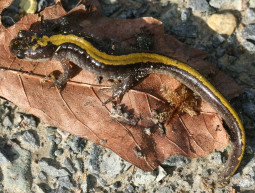 Long-toed salamanders are pretty distinctive. The vivid yellow stripe is a sure giveaway, as is the long toe on each back foot. But how did researchers in Waterton distinguish one long-toed salamander from the next? How could they possibly tell how many salamanders crossed the road without counting some twice?
Long-toed salamanders are pretty distinctive. The vivid yellow stripe is a sure giveaway, as is the long toe on each back foot. But how did researchers in Waterton distinguish one long-toed salamander from the next? How could they possibly tell how many salamanders crossed the road without counting some twice?
For years, researchers commonly clipped toes to mark the individuals they had counted – OUCH! Then they moved to marking the salamanders with a dye. In one study in Maryland, researchers injected red-backed salamanders with a bio-compatible, fluorescent elastomer pigment that could be checked using a portable ultra-violet light. But now computers and digital photography may save the salamanders from all these snippers and needles.
 An undergraduate student at North Carolina State University is using photo identification to ‘mark’ salamanders. She is creating a digital record of Eastern Tiger Salamanders in her study by photographing their natural patterns of spots, which are as unique as your fingerprints, then turning to a computer for help.
An undergraduate student at North Carolina State University is using photo identification to ‘mark’ salamanders. She is creating a digital record of Eastern Tiger Salamanders in her study by photographing their natural patterns of spots, which are as unique as your fingerprints, then turning to a computer for help.

Dartmouth researchers used WildID to conduct the largest ever study of giraffes.
The software called WildID is pretty nifty. It uses image analysis algorithms to extract, store, and compare pattern information from photographs, much like facial recognition software is used to identify people. WildID was developed by software engineers at Dartmouth College, New Hampshire, and has been used to successfully assess populations of animals like African penguins, cheetahs, harbour seals, plains zebras, and whale sharks.

The saddle patch is the white or gray area behind the orca’s dorsal (top) fin.
![]()
Long before WildID, species were studied using photographs and visual comparison. In the 1970s and 80s, Dr. Michael Bigg realized that the unique shape and pattern of an orca’s saddle patch and dorsal fin could aid in identifying individuals. Nicks, scars, and even bullet holes provide useful information. Today, marine scientists have photographed every resident orca in British Columbia, and now know the age, gender, diet, and range for each. Identification of individual orcas has enabled scientists to follow them through their lives, helping us understand the complexity of their family structures and culture. But it’s not easy – you can test your skill at identifying orcas with a cool game from the Vancouver Aquarium.

Manta rays can also be identified with photographs.
For more than twenty years, researchers in Kona, Hawaii, have been building a similar database of manta ray photos. The pattern of spots on a manta ray’s underside is as unique as an orca’s saddle patch, salamander’s stripe or your fingerprint. Another group, MantaMatcher, encourages people to submit photos of manta rays to add to their worldwide database. The MantaMatcha algorithm has identified 6,456 individuals from 13,699 reported encounters with manta rays. These gentle giants lack the barbed tail of other rays and the teeth of orcas, but their sheer size – more than 1600 kg (3000 lbs) – is intimidating, particularly considering a person must be underneath the ray to photograph it!
Researchers call this technique ‘photographic mark-recapture’. It’s a cost-effective, non-invasive way to study populations of animals. Pictures can be snapped while the animals are roaming about, have been captured or with remote cameras. And the best part is no more snippers or needles!
